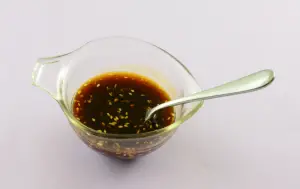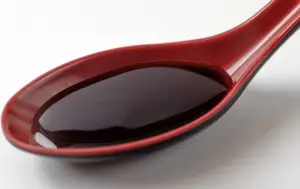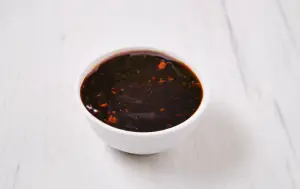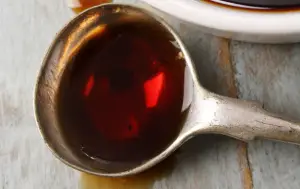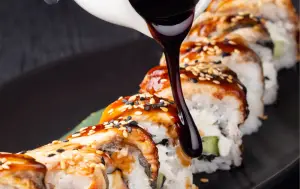Part 1: Introduction to Teriyaki Sauce: History and Origin
brief history of teriyaki sauce
Its significance in Japanese cuisine
Moreover, teriyaki sauce holds a place of significance in Japanese cuisine, symbolizing the harmonious blend of traditional and contemporary culinary practices. Its widespread popularity underscores Japan’s culinary influence on a global scale, with teriyaki dishes becoming a staple in restaurants and kitchens around the world. As a testament to its enduring appeal, teriyaki sauce continues to inspire innovation, leading to new variations and applications that honor its rich heritage while catering to modern tastes and dietary preferences.
What Makes Teriyaki Sauce Unique
Key ingredients (soy sauce, vinegar, ginger, garlic, mirin, and pineapple juice)
What sets teriyaki sauce apart from other condiments lies in its distinctive combination of key ingredients and the exquisite balance of flavors they create. Soy sauce forms the base, offering a deep, umami-rich foundation. Vinegar then introduces a bright acidity, cutting through the richness and adding a layer of complexity. Ginger and garlic contribute their signature warmth and pungency, elevating the sauce with aromatic spice. Mirin, a sweet rice wine, and occasionally pineapple juice infuse the sauce with a subtle sweetness, countering the saltiness of the soy sauce and the sharpness of the vinegar.
The balance of flavors: sweet, salty, and tangy
This harmonious blend of sweet, salty, and tangy flavors makes teriyaki sauce uniquely versatile. It can complement a wide range of dishes, from traditional Japanese recipes to contemporary fusion creations, without overpowering the natural flavors of the ingredients it accompanies. The sauce’s ability to enhance the taste of meats, vegetables, and even tofu underscores its adaptability and appeal across various cuisines. As a result, teriyaki sauce has not only become a beloved staple in Japanese cooking but has also gained international acclaim, captivating palates around the globe with its distinctive taste profile.
Understanding Teriyaki Sauce
Types of Teriyaki Sauce
Variations in recipes and flavors
Moreover, the variations in recipes and flavors between store-bought and homemade teriyaki sauce underscore the adaptability of this condiment. Whether opting for the ease of a bottled sauce or the personalized touch of a homemade version, teriyaki sauce remains a versatile and beloved element in culinary traditions worldwide. Its ability to bridge the gap between convenience and customization makes it a staple in both quick weeknight dinners and elaborate culinary creations.
How Teriyaki Sauce is Made
Traditional recipe
The creation of teriyaki sauce begins with a traditional recipe that has stood the test of time, blending soy sauce, mirin (a sweet rice wine), and sugar. This foundational trio forms the heart of teriyaki sauce, offering a perfect balance of sweetness and saltiness, with mirin adding a subtle depth and complexity. Chefs often introduce ginger and garlic to the mix, infusing the sauce with a warm, aromatic kick that complements the base flavors beautifully.
Modern adaptations for store-bought sauces
As teriyaki sauce made its way into the global culinary scene, modern adaptations emerged, especially in store-bought varieties. Manufacturers have innovated on the traditional recipe to cater to diverse tastes and dietary needs, incorporating ingredients like pineapple juice for added sweetness and a tangy edge, or adjusting the sugar content to create low-sugar or sugar-free options. Some brands also experiment with the addition of spices or citrus notes, broadening the sauce’s flavor profile to suit a wider range of dishes.
These modern adaptations ensure that teriyaki sauce remains a versatile and beloved condiment, whether used in traditional Japanese cooking or as a global kitchen staple. The essence of teriyaki sauce’s appeal lies in its ability to evolve while maintaining the delicate balance of flavors that make it uniquely irresistible.
Part 2: Using Teriyaki Sauce Cooking with Teriyaki Sauce
Stir-fry recipes
Marinades, grilled skewers, and appetizers
Marinades and grilled skewers benefit immensely from teriyaki sauce’s rich profile. Before grilling, soaking your meats or vegetables in teriyaki sauce infuses them with its signature flavors. The sugars in the sauce char slightly when exposed to high heat, offering a smoky, caramelized crust that’s utterly irresistible. Whether you’re preparing chicken skewers or marinated tofu, teriyaki acts as the secret ingredient that promises a mouthwatering outcome.
Tips for cooking with store-bought teriyaki sauce
When using store-bought teriyaki sauce, a few tips can enhance your cooking experience. First, consider the sauce’s sodium content, adjusting other salty ingredients in your dish accordingly to strike a perfect balance. For a thicker glaze, a quick simmer with a cornstarch slurry can add body to the sauce, making it ideal for coating or dipping. Lastly, don’t shy away from adding fresh ginger or garlic to personalize the flavor, making even a store-bought sauce feel custom-tailored to your taste. With these strategies, teriyaki sauce becomes a versatile ally in the kitchen, capable of transforming everyday meals into something truly special.
Best Teriyaki Sauce Brands
Overview of top brands (e.g., Panda Express Mandarin Teriyaki Sauce, P.F. Chang’s Teriyaki Sauce)
Navigating the world of teriyaki sauce, several brands stand out for their exceptional flavors and quality. Among them, Panda Express Mandarin Teriyaki Sauce shines brightly. This sauce captures the essence of traditional teriyaki while offering a unique twist with its mandarin notes. Its thick consistency and deep caramelized flavor balance sweet and salty perfectly, making it a favorite for homemade stir-fries. The inclusion of sesame oil, ginger, lemon juice, and a hint of cayenne pepper adds layers of complexity, setting it apart from its competitors.
Another noteworthy contender is P.F. Chang’s Teriyaki Sauce. This brand extends the culinary experience of its renowned restaurants to homes. Its teriyaki sauce, known for its smoky undertone and mild sweetness, excels as a marinade. The subtle use of pineapple juice not only tenderizes proteins but also introduces a tangy sweetness, enhancing the overall flavor profile. This sauce’s versatility and ability to marry well with a variety of ingredients make it a pantry staple for those looking to recreate restaurant-quality dishes at home.
What makes them stand out?
What sets these brands apart is not just their flavor but also their commitment to quality. Both Panda Express and P.F. Chang’s have mastered the art of bottling the complexity of teriyaki sauce, offering a convenient option for cooks seeking authentic taste without the hassle of making it from scratch. Their sauces stand as a testament to the fusion of traditional teriyaki elements with innovative twists, catering to modern palates while respecting the sauce’s rich heritage.

Teriyaki Sauce
- Total Time: 15 minutes
- Yield: About 1.5 cups 1x
- Diet: Gluten Free
Description
Teriyaki sauce is a classic Japanese condiment, known for its rich, glossy appearance and sweet-savory flavor profile. It’s commonly used for marinating or glazing meats and vegetables, adding a depth of flavor to a variety of dishes.
Ingredients
- 1/2 cup soy sauce
- 1/4 cup water
- 2 tablespoons sweet rice wine (mirin)
- 1/2 cup brown sugar
- 2 cloves garlic, minced
- 1 tablespoon fresh ginger, grated
- 1 tablespoon cornstarch
- 2 tablespoons cold water (for cornstarch slurry)
Instructions
- In a saucepan, combine soy sauce, 1/4 cup water, mirin, brown sugar, garlic, and ginger. Stir and cook over medium heat until the sugar dissolves.
- In a small bowl, mix cornstarch with 2 tablespoons of cold water to make a slurry.
- Add the cornstarch slurry to the saucepan, stirring constantly.
- Simmer until the sauce thickens to desired consistency, usually about 5-7 minutes.
- Remove from heat and let cool. The sauce will thicken further as it cools.
Notes
- Adjust the sweetness or saltiness to taste by varying the amount of sugar or soy sauce.
- The sauce can be stored in the refrigerator for up to a week.
- For a gluten-free version, use tamari or a gluten-free soy sauce.
- Prep Time: 5 minutes
- Cook Time: 10 minutes
- Category: Sauce
- Method: Simmering
- Cuisine: Japanese
Nutrition
- Calories: 25
- Sugar: 4g
- Sodium: 500mg
- Fat: 0g
- Carbohydrates: 5g
- Protein: 1g


